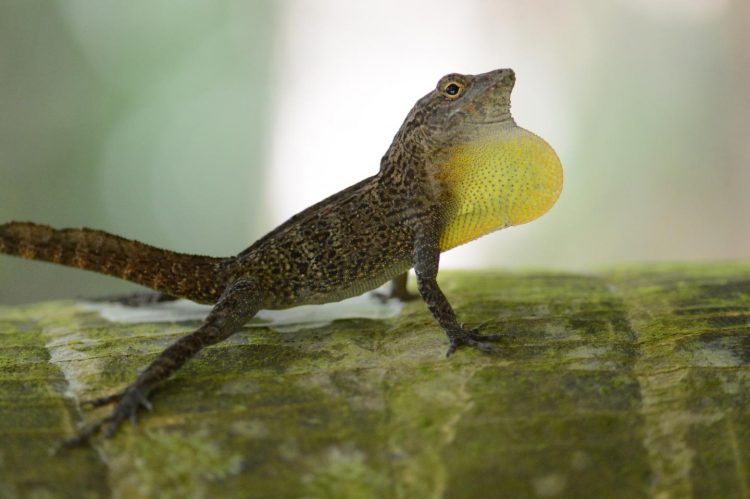Lizard activity levels can help scientists predict environmental change

A new Mizzou study reveals the crested anole is active over a broader range of temperatures than scientists had previously observed. Credit: Manuel Leal
Spring is here and ectotherms, or animals dependent on external sources to raise their body temperature, are becoming more active. Recent studies have shown that as the average global temperature increases, some lizards may spend more time in the shade and less time eating and reproducing, which could endanger many species. Now, a detailed field study of the Puerto Rican crested anole by a University of Missouri researcher shows that lizards are active over a broader range of temperatures than scientists previously thought–but when temperatures are either too hot or too cold, critical activity levels slow, limiting the abilities of species to cope with climate variability.
Like other cold-blooded animals, lizards have preferred body temperatures at which they hunt, eat, move quickly and reproduce. The active range for Puerto Rican crested anole is between 81 and 84 degrees Fahrenheit (27-29 degrees Celsius). Scientists previously projected that the lizards would no longer be active at hotter or cooler temperatures. The MU study shows a different perspective.
“We found that lizards were most active between the temperatures previously reported; however, above and below that range, lizards were still active,” said Manuel Leal, associate professor of biological sciences in the College of Arts and Science at MU. “Although climate change is still a major problem for lizards, our research indicates that their activity levels are less constrained by temperature than previously thought.”
In the study, Leal and Alex Gunderson, a postdoctoral fellow at the University of California-Berkeley, conducted behavioral observations and collected temperature data on hundreds of crested anoles in their native tropical habitat in Puerto Rico. They recorded the lizards' movements and behaviors over 15-minute intervals and measured the lizards' body temperatures.
“The findings suggest that scientists need to rethink how to model the activity of ectotherms and how temperature rise due to climate change may affect behavior,” Leal said. “Instead of treating activity as an on- or off-switch, we need to start thinking about activity as more of a dimmer switch, where behaviors are being dialed up and dialed down.”
The new modeling techniques presented in the study should provide scientists with the tools they need to create more targeted ways of determining the effects of climate variability on lizards' activities, such as eating and reproducing, Leal said.
###
The study, “Patterns of Thermal Constraint on Ectotherm Activity,” appears in the March 11 online issue of the journal American Naturalist.
Editor's Note: For more on the story, please see: http://biology.
Media Contact
All latest news from the category: Life Sciences and Chemistry
Articles and reports from the Life Sciences and chemistry area deal with applied and basic research into modern biology, chemistry and human medicine.
Valuable information can be found on a range of life sciences fields including bacteriology, biochemistry, bionics, bioinformatics, biophysics, biotechnology, genetics, geobotany, human biology, marine biology, microbiology, molecular biology, cellular biology, zoology, bioinorganic chemistry, microchemistry and environmental chemistry.
Newest articles

First-of-its-kind study uses remote sensing to monitor plastic debris in rivers and lakes
Remote sensing creates a cost-effective solution to monitoring plastic pollution. A first-of-its-kind study from researchers at the University of Minnesota Twin Cities shows how remote sensing can help monitor and…

Laser-based artificial neuron mimics nerve cell functions at lightning speed
With a processing speed a billion times faster than nature, chip-based laser neuron could help advance AI tasks such as pattern recognition and sequence prediction. Researchers have developed a laser-based…

Optimising the processing of plastic waste
Just one look in the yellow bin reveals a colourful jumble of different types of plastic. However, the purer and more uniform plastic waste is, the easier it is to…



